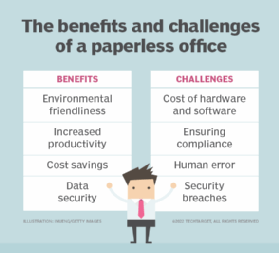What is a paperless office?
The paperless office is an umbrella term for business practices that improve the workplace by reducing reliance on paper.
While the paperless office could be used to describe a workplace where paper processes have been completely eliminated, it is more commonly used to describe methods by which companies can reduce costs and increase efficiency by making the transition from traditional paper processes to digital processes that are managed through computer software or services. Those scenarios often rely on enterprise content management (ECM) or collaboration software to share, edit or otherwise manage company documents that were formerly paper-based.
Benefits of a paperless office approach
In practice, companies typically take an incremental approach to achieve a paperless office, with a focus on eliminating paper from a specific workflow or business process. For example, a company could digitize document reviews and approvals.
In this case, creating a record digitally and completing that entire workflow in a digital format offers several benefits. These include the following:
- Reduces paper and printing expenses.
- Eliminates the need to scan the document into digital form.
- Saves time and effort -- and potentially the associated costs -- of transporting the physical documents to people involved with the workflow.
- Reduces paper disposal costs and the square footage required for records storage.

Another key aspect of a paperless office is revisiting paper processes, taking advantage of digital capabilities to automate or otherwise improve the efficiency of collaboration, workflows and other business processes. By revisiting processes, companies often find they can remove steps in the new digitized process, eliminating time wasted and unnecessary steps. In a travel expense approval process, a company may find some people don't need to approve the expense and can be taken out of the workflow.
Paperless processes can also be extended outside the enterprise, but the need to print/sign/scan documents is a common roadblock there. E-signature technology can eliminate the need for a physical signature and help convert traditional paper processes, such as contract signing, into digital processes.
Challenges of a paperless office
A paperless office can also present some challenges. They include the following:
- Digitalization requires a central repository that facilitates storage and collaboration -- typically an ECM system or service.
- Launching a paperless initiative requires employees to rethink how they work, along with possibly adopting new technology.
- Management should evaluate whether existing processes should be revisited to take full advantage of digital capabilities.
- Employees have often circumvented digitization because it requires logging on to a VPN to access centralized documents.
A paperless office is sometimes described as a holy grail type of goal, in that it represents an ideal that information governance professionals strive for, but in most cases, it's not practical or even desirable to remove all paper processes.
Editor's note: This article was originally published in 2021. Informa TechTarget editors revised to improve the reader experience.





